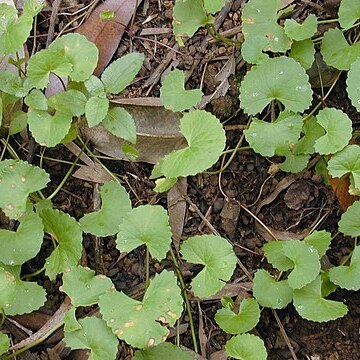Perennial herbs, sometimes woody at the base, procumbent to sprawling, scrambling or bushy and suberect. Leaves solitary or in groups of several together, simple, linear and terete to broadly reniform. Umbels numerous, simple, axillary, sessile or pedunculate; involucre of 2–4 bracts. Calyx-teeth obsolete. Petals greenish white or reddish purple, incurved but with no distinct apical lobule. Flowers all hermaphrodite, or else polygamous (not in E. Africa). Fruit glabrous or pilose, laterally compressed with the mericarps narrowed to the very narrow, flat commissure; primary ribs narrow but prominent, secondary ribs usually also obvious; vittae absent; stylopodia small to obsolete; styles short; carpophore absent. Endosperm strongly laterally compressed, elliptic, strengthened by a bony endocarp.
Perennial, sometimes suffruticose, erect, prostrate, or rooting at the nodes. Leaves entire, crenate or lobate, palminerved; petioles with sheaths. Umbels simple, sessile or subsessile. Involucres few or 0. Calyx teeth obsolete. Petals entire, imbricate in bud; disk plane, margin elevate; styles from the base filiformous. Fruits laterally flattened, vittae 0; commissure narrow; mericarps with dorsal ribs marginate, lateral and intermediate ribs arcuate, all connected by veins, sometimes with 2-4 secondary ribs.
Infl. a simple umbel subtended by 2 us. conspicuous bracts, Calyxteeth obsolete; petals whitish, imbricate in bud. Fr. laterally compressed, orbicular in outline, with narrow commissure. Mericarps flattened; primary ribs 3-5; secondary 3-5, prominent. Creeping perennial herbs with simple lvs; lamina ovate to ovate-cordate to reniform. About 25 spp., mainly of S. Africa and Asia, the N.Z. sp. endemic.
Much like Hydrocotyle; fr orbicular to reniform, flattened laterally, constricted at the commissure, with conspicuous primary dorsal ribs and 2 well developed secondary ones; umbels 1 or few, arising from the base, simple, head-like, with few (2–5) subsessile to short-pedicellate white fls; bracts 2, ovate; sep obsolete; perennial herbs with simple lvs. 40, mainly S. Hemisphere.
Fruit laterally flattened, somewhat constricted at the commissure; primary ribs usually well developed, sometimes with well-developed secondary ribs also; stylopodium obsolete, styles divergent; carpophore absent; commissural face of the seed flat.
An oil-bearing layer of cells is present beneath the pericarp epidermis and these occasionally differentiate into small vittae.
Flowers hermaphrodite or male, together or in separate umbels (male flowers often 3 together on a common pedicel).
Stems often procumbent and rooting at the nodes, sometimes decumbent and sprawling over rocks or other plants.
Umbels simple and axillary, sessile or pedunculate, with 1—many rays.
Perennial herbs becoming woody at the base in some species.
A layer of strengthening cells surrounds the seed cavity.
Involucre of 2 bracts persisting into the fruiting stage.
Petals greenish-white, sometimes tinged with red.
Leaves in groups of 2—many, rarely single.

